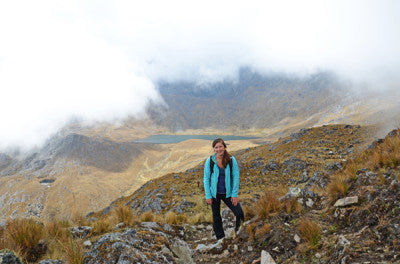Last week I was fortunate enough to be able to tag along on a trek with Apus Peru. The trip was a 5-day, 4-night adventure from Vilcabamba valley to Aguas Calientes, with the final day spent at Machu Picchu.

The glacier that towered above our campsite on the second night of the trek
The diversity of the natural surroundings we encountered inspired me especially in their connection to traditional textile weavings. From the high glacial peaks to the lush, steamy jungle, the backdrop of my trek was colorful and abundant with life. I saw some of the many native animals that are depicted in the icons on pasadizos and scarves, especially alpacas and llamas. As I walked through wide river valleys, I thought about how my surroundings have been the inspiration for Quechua textile weavings for thousands of years. As I crested the summits of Andean peaks, I saw the natural colors used to dye the alpaca fiber.
The dragonflower
Our guide, Urbano, helped me identify some of the unique plants and flowers that grow throughout the Vilcabamba valley and up on the mountain passes. A bright green plant that we found at the highest point of the trek is called “dragonflower,” and blossoms with yellow flowers during the rainy season. In the low, warm jungle we found different species of orchids, including a lovely violet one called “paradise orchid.”

Purple lupine
It was a wonderful and unique experience to spend time in the remote Andes among the natural elements that have been the subject matter for Quechua artisans for thousands of years. After this trek, I feel like I better understand the origins of the beautiful textiles that I work with in the Threads of Peru office.

Colorful jungle flowers
Written by Megan Malley

